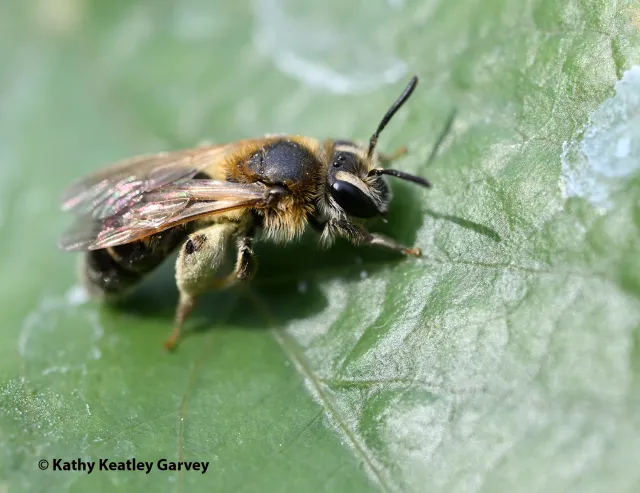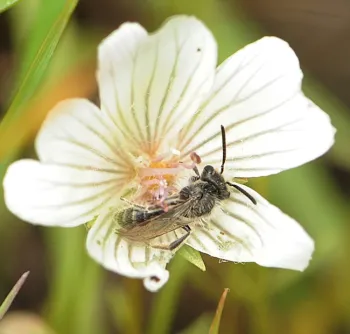
Bug Squad Blog
By Kathy Keatley Garvey
There she was, a mining bee (genus Andrena) sunning herself on a Passiflora (passionflower vine). She did not notice me.
Such a tiny bee, about the size of a grain of rice. It's a solitary ground-nesting bee known as "an early spring bee" and it lives only a few weeks.
We've seen the mining bees on our cherry laurels in Vacaville, and on meadowfoam at the Jepson Prairie Preserve, Dixon.
When they emerge, they quickly find a mate. "Mating is first on their agenda, followed by a quick meal of pollen to build up their ovaries," wrote bee scientists Robbin Thorp (1933-2019) and Gordon Frankie, authors of California Bees and Blooms: A Guide for Gardeners and Naturalists. "They then dig or forage for materials to construct their nests, and for food for their offspring. At the end of the short flight season, the adults die and the new generation's life cycle continues inside the nest."

The males have no burrows. "They spend the night inside the meadowfoam flower cups so they are frequently encountered as 'sleeping' inside them early in the morning. As soon as the sun warms them up, they go about their business searching for meadowfoam patches for females," as Thorp, a UC Davis distinguished emeritus professor of entomology told us.
These bees fly fast and are difficult to photography. Color?
"Most North American Andrena species are black, dull metallic blue, or green and moderately hairy, with bands of pale hair on their abdomens," according to the Xerces Society for Invertebrate Conservation. "Females have large, velvety facial depressions (foveae) that look like eyebrows and large pollen-collecting hairs (scopae) on the upper part of their hind legs, seemingly in their 'armpits.' Despite a variety of striking colorations, Andrenan species are difficult to tell part."
"They nest in the ground, typically in sandy soil and often near or under shrubs," Xerces points out. "The nest entrance is usually marked by a small mound (tumulus) of soil."
Andrena is the largest genus in the family Andrenidae, with more than 1300 species, and about 261 in California. They occur nearly worldwide (Americas, Eurasia and the Old World tropics). The tiniest Andrena of are only 7 millimeters long.
If you're lucky, you may see them at the Jepson Prairie Preserve, "home to one of the largest remaining examples of the vernal pools and native bunchgrass prairies that once covered California’s Central Valley."(See more on its website.)

